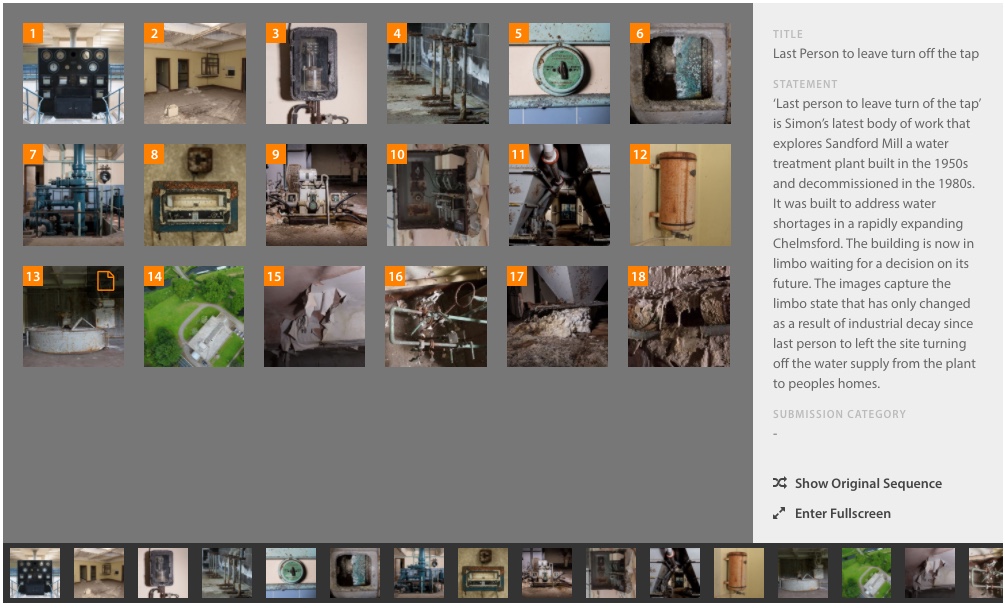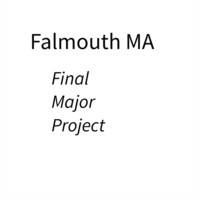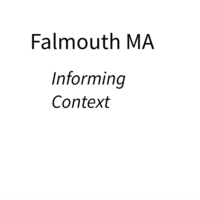During November I submitted some of my work for Exhibition at a New York gallery which included receiving a review of the submitted portfolio.

Their feedback on the body of work in included below:
Dear Simon,
Thank you very much for sharing your work. I’ve had some time to look at and assess your imagery, and I wish to offer you my feedback.
The aspect I like the most in your work is the precision with which you photograph this abandoned Sandford Mill a water treatment plant.
On the whole, each image is interesting and well composed.
I will try to answer your main questions:
Question 1: How would this project be perceived by an audience outside of the locale of the original story.
I resequenced some your photos to give your story a bit more impact and a better flow.
Your strongest photos are from #1 to #14. I started with image #1 which is really spectacular and gives a feeling of the machines and space of this Master Control Panel. and Then I basically put the Laboratory, and then after these broader shots, I tried to put one nice still like in the # 3. end, paying attention to the colour scheme. SO Image # 4 has a nice perspective, followed by # 5 and #6 which are great stills. ANd then another larger view in #7, followed by a still in # 8, etc… I ended on image #14 of the areal view of the plant.
Your weakest photos are the ones which are more generic to an abandoned factory and not as precise in their focus from image # 15 to # 18. They are not as well composed or focused on your point of view. I would replace them in your final portfolio. I would replace them with the following: I would perhaps insert a photo of the front of the plant, the entrance, as well as some details of the windows., a logo, or the name of the plant if it still there somewhere.
Question 2: The project is a resolved body of work, however, I am in discussion with the owners of the site to record the redevelopment of the site into a new future.
I think that would make a great follow-up to this body of work. It would show the evolution of the 50’to nowadays. Perhaps it could tell a bigger story. We would like to know: why was this plant abandoned? Did people leave this community and Why? IS the redevelopment a sign that the community is reviving?
I would suggest that you put this project within a larger sociological and economic vision of your area, in your home county of Essex, UK. It would make the story more relevant to a wider audience. Perhaps you could do a book, with the plant of the 50’s and the new redevelopment.
Question 3: I am looking for guidance and advice on the market my practice and engage with a broader audience.
In order to get noticed and recognized, I would advise you build one body of work in your home county of Essex, UK. This is what you are doing. But you need to focus a bit more on the general problems and especially re-contextualize the work as mentioned in the previous paragraph.
Here are the suggestions I would make:
Give better captions. Explain to use really what these machines did. Daphné Anglès, Picture Editor, The New York Times, Paris, France says: “A good text with the pictures is short, concise, to the point, informed, descriptive. I find it helps to imagine you are speaking to a smart child who would rather be outside playing with friends: you have very little time to tell the story and explain WHY it matters. The same holds true for captions. 1st sentence: describe the image. 2nd sentence: why and how this image fits into the body of work.”
Look at the work of Taryn Simon who catalogues and documents objects in a great way.
Also get inspired by this body of work: Governors Island By Lisa Kereszi & Andrew Moore: Detroit. See how these photographs framed their project so that they could express a bigger sociological and economic shift.
Look at The New York Times Lens blog for documentary and photojournalism stories. Good examples of photographers’ own statements and captions.
I would spend some time focusing on your writings. While you are first and foremost a visual artist, being able to discuss your work is an invaluable skill. Words help a gallery be able to articulate who you are as an artist as well as the ideas your images convey.
I think that Biographical Statement (Background) should be different and longer. The background should be a written paragraph on who you are as an artist. What motivates you? Excites you?
The Artist Statement is more of a discussion of this specific series. What we are seeing, how we should engage with the work, and what you want us to take away from the series. Avoid making too many generalizations, that is not necessarily related to the body of work we are reviewing. As an example, this phrase is too vague: ‘ Simon is comfortable with this paradox of place and his work has developed a rhythm of the waves that are cyclical yet never repeated. It is a nice phrase but too vague.
When broken out, these statements combine to give us a clearer picture of you, your ideas and your artistry. Addressing these issues will open up exhibition and publishing opportunities for your work and provide added value for curators and collectors.
Once you have 15-20 of these images re-edited, and recontextualized, you could consider attending some of the portfolio reviews and resubmitting to competitions in the list below. Reviews and festivals are excellent places to meet a network of professionals and peers that can really help you grow.
Going forward, you capture the soulfulness of an abandoned plant, as so many are in so many of our industrial countries, which re-contextualized could have a universal appeal.
Thank you again for giving me the opportunity to see your images. I wish you the best in your creative endeavours.
Additional Recommendations
Recommended Books & Photographers
Robert Polidori
Governors Island By Lisa Kereszi & Andrew Moore Andrew Moore: detroit
Taryn Simon
Photo Competitions
LensCulture Exposure Awards
Other Resources
New York Times Lens blog for documentary and photojournalism stories. Good examples of photographers’ own statements and captions.
Relevant Quotes from Past Jurors
“What separates a good photo from a great photo is a feeling somewhere between what I feel physically and what I would call an ‘aesthetic experience.’ It’s almost like the beginning of a love affair, you are just drawn to the image, you are lifted off your feet, you are moved. You just have to have it. You want to ask them to dance.” — Sarah Leen, Director of Photography, National Geographic, Washington, DC, USA
“If you’ve created a series of images, think of them as a story. Choose a very strong image to start off the series to make a powerful first impression.” — Jim Casper, Editor & Publisher of LensCulture
“Every image should contribute something fresh and new to the series and help add character to the submission. A strong submission can be as few as 5 images, or as many as 10 or 15 or more.” — Jim Casper, Editor & Publisher of LensCulture
“I am interested in pictures that educate the viewer about a topic. I’m drawn to sociopolitical landscapes or personal human dramas that can be viewed in a wider context beyond the depicted subject, as well as art that pushes the boundaries of traditional photography.” — Natasha Egan, Executive Director, Museum of Contemporary Photography, Columbia College, Chicago, IL, USA
My own Reflection
Having read the review my feeling is the feedback is a positive with confirmation of the direction I have taken with this body of work and the one that I have developed for submission in the current module.
Of the images in this body of work they considered as strong 6 of those were images that were part of the London Photo Show exhibition for October which were images 1, 3, 7, 8, 9 and 10. The remaining two images I selected for the show were 16 and 17.
There was positive feedback on the suggestion of following the redevelopment of the site which is now something that is in track to progress with the idea of creating a book which was also a suggestion from Mark Power’s review of the work.
The other recommendation of shooting work focused on Essex again remains very much consistent with the direction of development within my practice.
I continue to use the mix of large scale and detail images alternating as I progress in my current body of work though I have introduced a new technique to explore the relationship between the piers and the sea that surrounds them.




Pingback: Portfolio Clinic – Anna and Stella – F2F Workshop